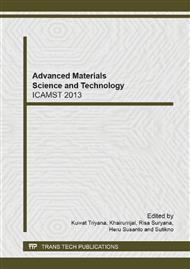p.646
p.650
p.656
p.660
p.664
p.668
p.672
p.676
p.681
Automation of Four Circle Diffractomete /Texture Diffractometer for Studies of Crystal Structure and Texture Measurements
Abstract:
National Nuclear Energy Agency of Indonesia has several neutron beam instruments for materials science research. One of the instrument is Four Circle Diffractometer / Texture Diffractometer for study of crystal structure and texture measurement. Due to the instrument is fully occupied by many samples, the instruments has to be further developed in order to conduct experiment effectively and efficiently. For that reason, the instrument controller has been replaced with a new programmable controller that can handle all axis simultaneously. Since the controller has been replaced with the new one, a software for data acquisition and measurement also has been modified using a visual basic of programming language with an addition of function, i.e. an automatic measurement for either single-crystal or poly-crystal sample. The software calculates four peaks of Miller indices of the sample for determining the crystal position to be scanned. Then, the software performs the automatic measurement started from scanning the axis of θ-2θ, calculating the peak position by fitting the data obtained from sample diffraction data, then positioning the θ and 2θ axis to the peak position. Finally, the software performs the scanning of the π-χ axis for texture analysis, and save the experiment data into a certain format for the texture analysis software, i.e. Material Analysis Using Diffraction (MAUD).
Info:
Periodical:
Pages:
664-667
Citation:
Online since:
February 2014
Authors:
Keywords:
Price:
Сopyright:
© 2014 Trans Tech Publications Ltd. All Rights Reserved
Share:
Citation:


